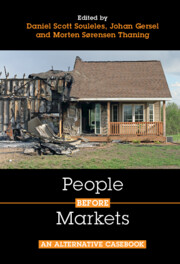Book contents
- People Before Markets
- People Before Markets
- Copyright page
- Dedication
- Contents
- Contents by Topic
- Authors
- 1 Introduction: Why Are You Here?
- 2 Some Philosophical Help with “Neoliberalism”
- Part I Our World
- 3 Where Should Food Come From?
- 4 Where Should Water Come From?
- 5 Who Gets to Own Land?
- 6 How Should Food be Produced?
- 7 Who Decides Where They Live?
- 8 How Much Land Do We Need?
- 9 Where Should We Park?
- 10 How Should We Deal with Climate Change?
- 11 How Should We Make an Impact?
- Part II Our Lives
- Part III Our Work
- Index
- References
4 - Where Should Water Come From?
from Part I - Our World
Published online by Cambridge University Press: 27 October 2022
- People Before Markets
- People Before Markets
- Copyright page
- Dedication
- Contents
- Contents by Topic
- Authors
- 1 Introduction: Why Are You Here?
- 2 Some Philosophical Help with “Neoliberalism”
- Part I Our World
- 3 Where Should Food Come From?
- 4 Where Should Water Come From?
- 5 Who Gets to Own Land?
- 6 How Should Food be Produced?
- 7 Who Decides Where They Live?
- 8 How Much Land Do We Need?
- 9 Where Should We Park?
- 10 How Should We Deal with Climate Change?
- 11 How Should We Make an Impact?
- Part II Our Lives
- Part III Our Work
- Index
- References
Summary
This chapter looks at the provision of water by two different Southern California water agencies. One jurisdiction seeks to meet its water needs by financing and buying water from an expensive, energy-intensive desalination plant; the other jurisdiction successfully persuades its residents to reduce and change their consumption patterns of water and saves a huge amount of money as compared to the agency that bought into the desalination plant. What’s interesting from our book’s critical point of view is that the water agencies had different ideas about how people behave as water consumers. The jurisdiction that bought the expensive and wasteful desalination plant spent far more money and ended up wasting a huge amount of water because they didn’t even entertain the idea that people’s water consumption habits could change. Like good neoliberals they assumed that people were selfish, that they are attempting to maximize their individual utility, and that they had relatively stable preferences, which it would be foolish to attempt to change substantially. They paid dearly for those assumptions. In addition, the case demonstrates, how even in relation to complex problems such as handling water supplies, conscious human prediction and problem-solving can outperform market-based mechanisms. The case shows, in opposition to neoliberal orthodoxy, that it is possible to plan.
Keywords
- Type
- Chapter
- Information
- People before MarketsAn Alternative Casebook, pp. 79 - 94Publisher: Cambridge University PressPrint publication year: 2022



